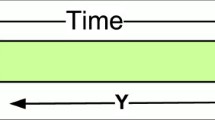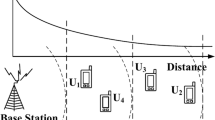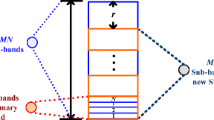Abstract
A multiple access protocol, based on a Reservation Random Access (RRA) scheme, is derived for a wireless cellular network carrying real-time and data traffic. Given a TDMA framed channel and a cellular structure, the aim of the protocol is that of maximizing the one-step throughput over an entire frame. This is achieved by deciding on the access rights at the cell base station, which then broadcasts this information at the beginning of the frame. The decision is made on the basis of binary channel feedback information (collision/no collision) over the previous frames, as well as of long term averages of packet generation rates at the mobile stations, assuming independence in the presence of packets at the latter. The resulting protocol has therefore been termed Independent Stations Algorithm (ISA), and the overall scheme RRA-ISA. As in other RRA protocols, time constrained (e.g., voice) traffic operates in a dynamic reservation mode, by contending for a slot in the frame with the first packet of a burst, and then keeping the eventually accessed slot for the duration of the burst; packets of the time constrained traffic unable to access a slot within a maximum delay are dropped from the input buffer. No such constraint is imposed on data traffic. Together with the “basic” version of the access algorithm, three other variants are presented, which exploit three simple different priority schemes in the RRA-ISA “basic” structure, in order to give a prominence to the voice service. The aim of these variants is to improve the performance in terms of the maximum number of stations acceptable in the system, by slightly increasing the data packets delay. All the proposed schemes are analyzed by simulation in the presence of voice and data traffic. Several comparisons show a relevant performance improvement (in terms of data delay and maximum number of voice stations acceptable within a cell) over other protocols that use ALOHA as a reservation mechanism (RRA-ALOHA or PRMA schemes).
Similar content being viewed by others
References
D.J. Goodman, Trends in cellular and cordless communications, IEEE Comm. Mag. 29(6) (June 1991) 31–40.
D.J. Goodman, Cellular packet communications, IEEE Trans. Comm. 38(8) (August 1991) 1272–1280.
D.J. Goodman, R.A. Valenzuela, K.T. Gayliard and B. Ramamurthi, Packet reservation multiple access for local wireless communications, IEEE Trans. Comm. 37(8) (August 1989) 885–890.
D.J. Goodman and S.X. Wei, Efficiency of packet reservation multiple access, IEEE Trans. Vehicular Technol. 40(1) (February 1991) 170–176.
S. Nanda, D.J. Goodman and U. Timor, Performance of PRMA: a packet voice protocol for cellular systems, IEEE Trans. Vehicular Technol. 40(3) (August 1991) 584–598.
M. Frullone, G. Falciasecca, P. Grazioso, G. Riva and A.M. Serra, On the performance of packet reservation multiple access with fixed and dynamic channel allocation, IEEE Trans. Vehicular Technol. 42(1) (February 1993) 78–86.
M. Frullone, G. Riva, P. Grazioso and C. Carciofi, Packet reservation multiple access in cellular environments, Europ. Trans. Telecomm. 5(1) (January/February 1994) 51–58.
M. Paterakis and A.C. Cleary, On the voice-data integration in third generation wireless access communication networks, Europ. Trans. Telecomm. 5(1) (January/February 1994) 11–18.
M. Frullone, G. Riva, P. Grazioso and M. Missiroli, Comparisons of multiple access schemes for personal communication systems in a mixed cellular environment, IEEE Trans. Vehicular Technol. 43(1) (February 1994) 99–109.
S. Jangi and L.F. Merakos, Performance analysis of reservation random access protocols for wireless access networks, IEEE Trans. Comm. 42(2/3/4) (February/March/April 1994) 1223–1234.
S. Nanda, Stability evaluation and design of the PRMA joint voice data system, IEEE Trans. Comm. 42(5) (May 1994) 2092–2104.
R. Bolla, F. Davoli, F. Reichert and M. Taffone, The PRMA-ISA protocol for multiple access of mixed voice and data traffic, in: Proc. 44th IEEE Vehicular Technol. Conf., Stockholm, Sweden (June 1994) pp. 1213–1217.
R. Bolla, F. Davoli, A. Iscra, C. Nobile and S. Zappatore, Analysis and performance comparison of the RRA-ISA multiple access protocol for packet voice and data cellular systems, in: Proc. Personal, Indoor and Mobile Radio Comm. Symp. (PIMRC '95), Toronto, Canada (September 1995) pp. 378–382.
P.T. Brady, A model for generating on-off speech patterns in two-way conversations, Bell Syst. Techn. J. 48 (September 1969) 2445–2472.
M. Aicardi, G. Casalino and F. Davoli, Independent stations algorithm for the maximization of one-step throughput in a multi-access channel, IEEE Trans. Comm. 35(8) (August 1987) 795–800.
M. Aicardi, G. Casalino, F. Davoli and R. Minciardi, A multi-access scheme for the maximization of one-step throughput, Internat. J. Mini and Micro Computers 8(3) (1986) 65–69.
M. Aicardi, F. Davoli and A. Giordano, Radio ISA Net: a centralized single-hop packet radio network for PC-to-mainframe interconnection, IEEE J. Selected Areas Comm. 7(2) (February 1989) 219–225.
M. Aicardi, F. Davoli, A. Giordano and S. Zappatore, Design and analysis of a MAC-layer protocol for a car-to-infrastructure packet radio network, IEEE Trans. Vehicular Technol. 41(2) (May 1992) 152–158.
S. Tasaka, Performance Analysis of Multiple Access Protocols (MIT Press, Cambridge, MA, 1986).
Author information
Authors and Affiliations
Rights and permissions
About this article
Cite this article
Bolla, R., Davoli, F. & Nobile, C. The RRA‐ISA multiple access protocol with and without simple priority schemes for real‐time and data traffic in wireless cellular systems. Mobile Networks and Applications 2, 45–53 (1997). https://doi.org/10.1023/A:1013203910607
Issue Date:
DOI: https://doi.org/10.1023/A:1013203910607




